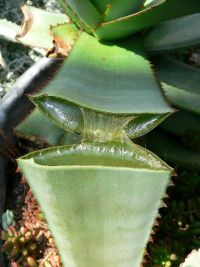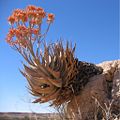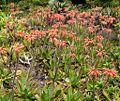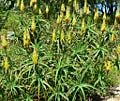Difference between revisions of "Aloe" - New World Encyclopedia
Rick Swarts (talk | contribs) (added article from Wikipedia and credit/category tags) |
Rick Swarts (talk | contribs) |
||
| Line 91: | Line 91: | ||
*Farrar, Maureen Meyers. Skin Deep. ''Better Nutrition'' July 2005. | *Farrar, Maureen Meyers. Skin Deep. ''Better Nutrition'' July 2005. | ||
*''British Journal of General Practice'', October 1999 | *''British Journal of General Practice'', October 1999 | ||
| + | |||
| + | |||
| + | Longe, Jacqueline L. 2005. The Gale encyclopedia of alternative medicine. Farmington Hills, Mich: Thomson/Gale. http://galenet.galegroup.com/servlet/eBooks?ste=22&docNum=CX3435199999&q=gvltec%5Fmain. ISBN: 0787693960 | ||
==Links== | ==Links== | ||
Revision as of 21:48, 2 May 2007
| Aloe | ||||||||||||
|---|---|---|---|---|---|---|---|---|---|---|---|---|
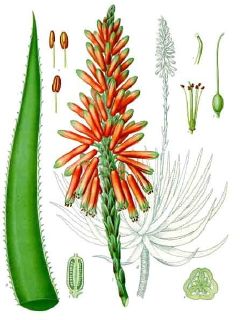 Aloe succotrina
| ||||||||||||
| Scientific classification | ||||||||||||
| ||||||||||||
|
See Species |
- For other uses, see Aloe (disambiguation).
Aloe, also written Aloë, is a genus containing about four hundred species of flowering succulent plants.
The genus is native to Africa and is common in South Africa's Cape Province and the mountains of tropical Africa, and neighbouring areas such as Madagascar, the Arabian peninsula and the islands off Africa.
The APG II system (2003) placed the genus in the family Asphodelaceae. In the past it has also been assigned to families Aloaceae and Liliaceae. Members of the closely allied genera Gasteria, Haworthia and Kniphofia which have a similar mode of growth, are also popularly known as aloes. Note that the plant sometimes called "American aloe" (Agave americana), belongs to Agavaceae, a different family.
Most Aloes have a rosette of large, thick, fleshy leaves. The leaves are often lance-shaped with a sharp apex and a spiny margin. Aloe flowers are tubular, frequently yellow, orange or red and are borne on densely clustered, simple or branched leafless stems.
Many species of Aloe are seemingly stemless, with the rosette growing directly at ground level; other varieties may have a branched or un-branched stem from which the fleshy leaves spring. They vary in colour from grey to bright green and are sometimes striped or mottled.
Uses
Aloe species are frequently cultivated as ornamental plants both in gardens and in pots. Many Aloe species are highly decorative and are valued by collectors of succulents. Some species, in particular Aloe vera are purported to have medicinal properties.
Other use of Aloes include their role in alternative medicines (see Herbalism) and in home first aid. Both the translucent inner pulp as well as the resinous yellow exudate from wounding the Aloe plant is used externally to relieve skin discomforts and internally as a laxative. To date, some research has shown that Aloe vera produces positive medicinal benefits for healing damaged skin. Conversely, other research suggests Aloe vera can negatively effect healing (Vogler and Ernst, 1999).
Some Aloe species have also been used for human consumption. For example, drinks made from or containing chunks of aloe pulp are popular in Asia as commercial beverages and as a tea additive; this is notably true in Korea.
External uses
Various extracts of Aloe vera are frequently used in herbal medicine and by cosmetic companies. For more information see: Aloe vera.
Internal uses
Aloe contains a number of medicinal substances used as a purgative. The medicinal substance is produced from various species of aloe, such as A. vera, A. vulgaris, A. socotrina, A. chinensis, and A. perryi. Several kinds of aloes are commercially available: Barbadoes, Socotrine, Hepatic, Indian, and Cape aloes. Barbadoes and Socotrine are the varieties most commonly used for curative purposes [citation needed].
Aloes is the expressed juice of the leaves of the plant. When the leaves are cut, the juice that flows out is collected and evaporated. After the juice has been removed, the leaves are sometimes boiled to yield an inferior kind of aloes. The juice of the leaves of certain species, e.g. Aloe venenosa, is poisonous.
There have been very few properly conducted studies about possible benefits of aloe gel taken internally. One study found improved wound healing in mice. Another found a positive effect of lowering risk factors in patients with heart disease. Some research has shown decreasing fasting blood sugar in diabetic animals given aloe [1]. None of these studies can be considered to be definitive, and there are many false advertising claims for aloe.
Aloe has been marketed as a remedy for coughs, wounds, ulcers, gastritis, diabetes, cancer, headaches, arthritis, immune-system deficiencies, and many other conditions when taken internally. However, these uses are unsubstantiated; the only substantiated internal use is as a laxative. Furthermore, there is evidence of potential adverse side effects (for example, acute hepatitis[1]). Although some studies suggest that certain components of aloe such as aloe-emodin have genotoxic activity, human clinical trials and rodent carcinogenicity studies do not substantiate a genotoxic risk to humans when aloe products are consumed as directedBrusick D, Mengs U (1997). Assessment of the genotoxic risk from laxative senna products. Environ Mol Mutagen 29 (1): 1-9. PMID 9020301..
On 9 May 2002, the U.S. Food and Drug Administration issued a final rule banning the use of aloe and cascara sagrada as laxative ingredients in over-the-counter drug products[2].
Chemical properties of Aloin
Aloins are soluble and easily extracted by water. Aloes is the expressed juice of the leaves of the plant. When the leaves are cut, the juice that flows out is collected and evaporated. After the juice has been removed, the leaves are sometimes boiled, to yield an inferior kind of aloes. According to W. A. Shenstone, two classes of Aloins are to be recognized: (1) nataloins, which yield picric and oxalic acids with nitric acid, and do not give a red coloration with nitric acid; and (2) barbaloins, which yield aloetic acid (C7H2N3O5), chrysammic acid (C7H2N2O6), picric and oxalic acids with nitric acid, being reddened by the acid. This second group may be divided into a-barbaloins, obtained from Barbadoes aloes, and reddened in the cold, and b-barbaloins, obtained from Socotrine and Zanzibar aloes, reddened by ordinary nitric acid only when warmed or by fuming acid in the cold. Nataloin (2C17H13O7·H2O) forms bright yellow scales. Barbaloin (C17H18O7) forms yellow prismatic crystals. Aloes also contain a trace of volatile oil, to which its odour is due.[citation needed]
In homeopathic medicine aloe is used for hemorrhoids[2].
ReferencesISBN links support NWE through referral fees
- ↑ Acute hepatitis induced by an Aloe vera preparation: a case report
- ↑ Morrsion, MD, Roger (1993). Desktop guide to keynotes and comfirmatory symptoms. Grass Valley, CA: Hahnemann Clinic Publishing.
Heraldry
The aloe plant (A. rubrolutea) occurs as a charge in heraldry, such as in the Civic Heraldry of Namibia [3]
Species
There are around 400 species in the genus Aloe. For a full list, see List of species of genus Aloe. Species include:
- Aloe arborescens - Aloe Arborescens Miller, used in healthcare
- Aloe aristata - Torch Plant, Lace Aloe
- Aloe dichotoma - quiver tree or kokerboom
- Aloe ngobitensis
- Aloe variegata - Partridge-breasted Aloe, Tiger Aloe
- Aloe vera Barbados Aloe, Common Aloe, Yellow Aloe, Medicinal Aloe. This is the variety used medicinally.
- Aloe wildii
References
- Schmidt JM, Greenspoon JS (1991) Aloe vera dermal wound gel is associated with a delay in wound healing. Obstet Gynecol 1: 115-117.
- Vogler BK, Ernst E (1999) Aloe vera: a systematic review of its clinical effectiveness British Journal of General Practice 49: 823-828.
- International Aloe Science Council: http://www.iasc.org/aloe.html
- University of Maryland Medical Center: http://www.umm.edu/altmed/ConsHerbs/Aloech.html
- Craig, Winston. The All-purpose Gel. Vibrant Life July 2001.
- Farrar, Maureen Meyers. Skin Deep. Better Nutrition July 2005.
- British Journal of General Practice, October 1999
Longe, Jacqueline L. 2005. The Gale encyclopedia of alternative medicine. Farmington Hills, Mich: Thomson/Gale. http://galenet.galegroup.com/servlet/eBooks?ste=22&docNum=CX3435199999&q=gvltec%5Fmain. ISBN: 0787693960
Links
List of Southern African indigenous trees
External links
Images
Credits
New World Encyclopedia writers and editors rewrote and completed the Wikipedia article in accordance with New World Encyclopedia standards. This article abides by terms of the Creative Commons CC-by-sa 3.0 License (CC-by-sa), which may be used and disseminated with proper attribution. Credit is due under the terms of this license that can reference both the New World Encyclopedia contributors and the selfless volunteer contributors of the Wikimedia Foundation. To cite this article click here for a list of acceptable citing formats.The history of earlier contributions by wikipedians is accessible to researchers here:
The history of this article since it was imported to New World Encyclopedia:
Note: Some restrictions may apply to use of individual images which are separately licensed.

